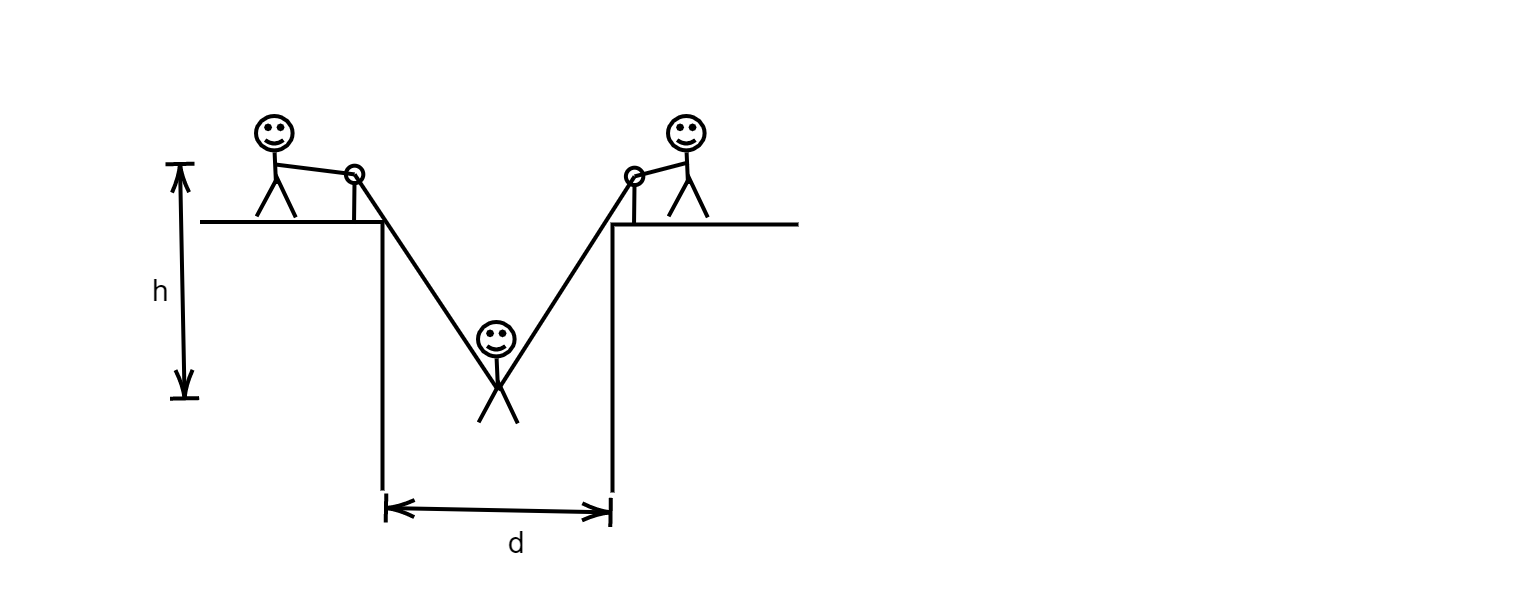
A man has fallen into a ditch of width $d$ and two of his friends are slowly pulling him out using a light rope and two fixed pulleys as shown in the figure. Show that the force (assumed equal for both the friends) exerted by each friend on the rope increases as the man moves up. Find the force when the man is at a depth $h$.


Answer
519.9k+ views
Hint: To solve these types of questions, our first step should be to make a detailed free body diagram so that we can figure out how the forces are acting on the system. Next step would be to form equations of forces and then solve them to get the required results.
Complete answer:
Let us first draw the free body diagram for better understanding and assume that the rope makes an angle $\theta $ with the vertical.

On observing the free body diagram, we can conclude that:
$\begin{align}
& F\cos \theta +F\cos \theta =mg \\
& \Rightarrow 2F\cos \theta =mg \\
& \Rightarrow F=\dfrac{mg}{2\cos \theta } \\
\end{align}$
As the man’s friends pull him up, the angle that the rope makes with the vertical will increase and thus $\cos \theta $ will decrease.
We know that $\cos \theta $ is the length of the base of a right-angle triangle divided by the length of the hypotenuse, hence in this case we will consider the depth of the ditch as the base of the triangle and the length of the rope as the length of the hypotenuse, and hence we will get the following value:
\[\cos \theta =\dfrac{h}{\sqrt{\left( \dfrac{d}{2} \right)+{{h}^{2}}}}\]
Substituting this value in equation of force, we get:
\[\begin{align}
& F=\dfrac{mg}{2\dfrac{h}{\sqrt{{{\left( \dfrac{d}{2} \right)}^{2}}+{{h}^{2}}}}} \\
& \Rightarrow F=\dfrac{mg}{2\dfrac{h}{\sqrt{\dfrac{{{d}^{2}}+4{{h}^{2}}}{4}}}} \\
& \Rightarrow F=\dfrac{mg}{4\dfrac{h}{\sqrt{{{d}^{2}}+4{{h}^{2}}}}} \\
& \therefore F=\dfrac{mg}{4h}\sqrt{{{d}^{2}}+4{{h}^{2}}} \\
\end{align}\]
Hence, the force exerted by each of the friends increases as the man moves up.
Note:
An infinite amount of force would have to be applied to make the depth of the ditch zero, because force is inversely proportional to zero, hence if depth of the ditch decreases, i.e., as the man moves up, the force also increases and it would be practically impossible to make the horizontally straight by pulling the rope.
Complete answer:
Let us first draw the free body diagram for better understanding and assume that the rope makes an angle $\theta $ with the vertical.

On observing the free body diagram, we can conclude that:
$\begin{align}
& F\cos \theta +F\cos \theta =mg \\
& \Rightarrow 2F\cos \theta =mg \\
& \Rightarrow F=\dfrac{mg}{2\cos \theta } \\
\end{align}$
As the man’s friends pull him up, the angle that the rope makes with the vertical will increase and thus $\cos \theta $ will decrease.
We know that $\cos \theta $ is the length of the base of a right-angle triangle divided by the length of the hypotenuse, hence in this case we will consider the depth of the ditch as the base of the triangle and the length of the rope as the length of the hypotenuse, and hence we will get the following value:
\[\cos \theta =\dfrac{h}{\sqrt{\left( \dfrac{d}{2} \right)+{{h}^{2}}}}\]
Substituting this value in equation of force, we get:
\[\begin{align}
& F=\dfrac{mg}{2\dfrac{h}{\sqrt{{{\left( \dfrac{d}{2} \right)}^{2}}+{{h}^{2}}}}} \\
& \Rightarrow F=\dfrac{mg}{2\dfrac{h}{\sqrt{\dfrac{{{d}^{2}}+4{{h}^{2}}}{4}}}} \\
& \Rightarrow F=\dfrac{mg}{4\dfrac{h}{\sqrt{{{d}^{2}}+4{{h}^{2}}}}} \\
& \therefore F=\dfrac{mg}{4h}\sqrt{{{d}^{2}}+4{{h}^{2}}} \\
\end{align}\]
Hence, the force exerted by each of the friends increases as the man moves up.
Note:
An infinite amount of force would have to be applied to make the depth of the ditch zero, because force is inversely proportional to zero, hence if depth of the ditch decreases, i.e., as the man moves up, the force also increases and it would be practically impossible to make the horizontally straight by pulling the rope.
Recently Updated Pages
Why are manures considered better than fertilizers class 11 biology CBSE

Find the coordinates of the midpoint of the line segment class 11 maths CBSE

Distinguish between static friction limiting friction class 11 physics CBSE

The Chairman of the constituent Assembly was A Jawaharlal class 11 social science CBSE

The first National Commission on Labour NCL submitted class 11 social science CBSE

Number of all subshell of n + l 7 is A 4 B 5 C 6 D class 11 chemistry CBSE

Trending doubts
What is meant by exothermic and endothermic reactions class 11 chemistry CBSE

10 examples of friction in our daily life

One Metric ton is equal to kg A 10000 B 1000 C 100 class 11 physics CBSE

1 Quintal is equal to a 110 kg b 10 kg c 100kg d 1000 class 11 physics CBSE

Difference Between Prokaryotic Cells and Eukaryotic Cells

What are Quantum numbers Explain the quantum number class 11 chemistry CBSE




